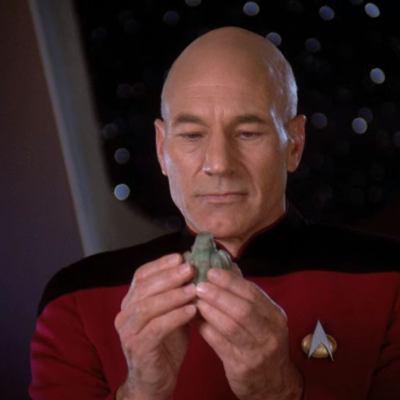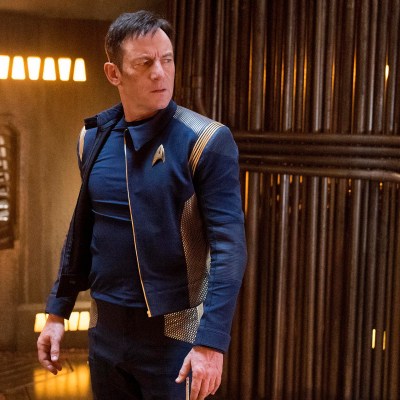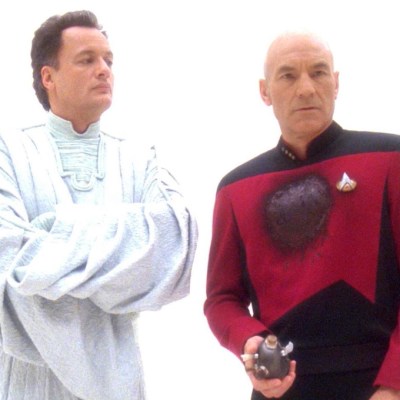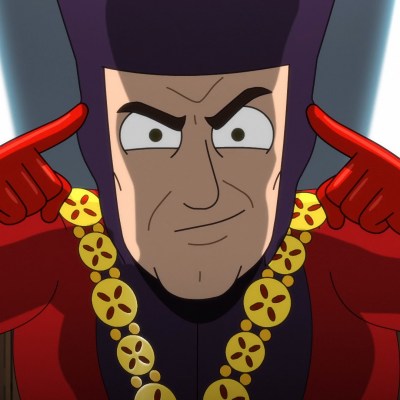Star Trek: Bringing the Enterprise Home, 55 Years Later
We talked to Star Trek: Year Five creators Jackson Lanzing and Collin Kelly about completing the Original Series' five-year mission.
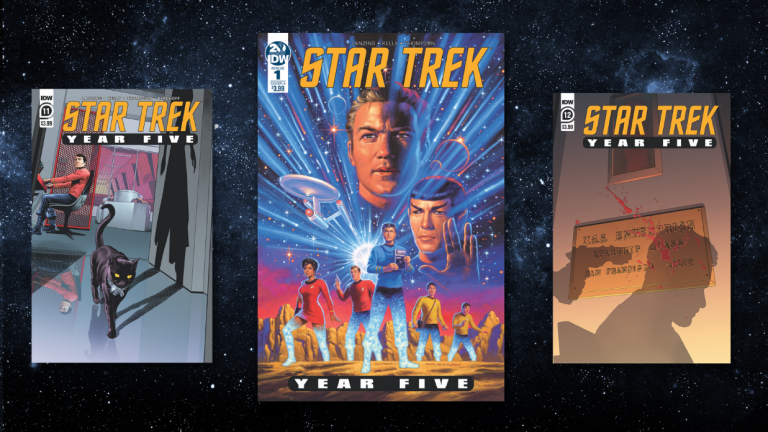
All odysseys must end.
The final year of the starship Enterprise’s five-year mission has long been speculated about, but never before been given such descriptive and reverential treatment as in IDW’s Star Trek: Year Five, a comic written by Jackson Lanzing and Collin Kelly. Yet, it too must come to an end as the intrepid crew of The USS Enterprise complete their final year of exploration in this true-to-The-Original-Series story that wraps up this summer. Den of Geek was able to sit down with Lanzing and Kelly to talk about the journey, its challenges, and how they managed to bring the Enterprise home in this epic comic series that gives the final year of James T. Kirk and the crew of the Enterprise’s mission the proper examination it deserved.
“I’m happy to have finally landed the ship,” Lanzing tells us, before continuing in a bittersweet tone: “I’m sad. Star Trek means so much to me and Collin. We’re enormous fans and we have been shaped by it in a lot of ways and fought really hard to get to work on it. Hitting that point, and getting to work on it with such an iconic crew of the original series – it felt like we couldn’t drop the ball on this. When we got it – we felt the enormous weight of responsibility that it had to stand apart from other Star Trek books.”
Which, of course, was the purpose for this odyssey. This series had to be different from other Star Trek comics and there could be no other way to show its distinction by exploring the ending of The Original Series. As any loyal Trek fan knows, TOS ran for only three seasons. It survived, sporadically appearing in novels and other literature. There was room to create stories about the seasons that never were. For many writers and fans, additional stories were just accepted to be in that missing time span. Some even accept The Animated Series to be the missing years, but there was never any formal acknowledgment that, when that series ended, so did the Enterprise’s five-year mission.
Star Trek: Year Five boldly announced its finite nature from the start. With 24 issues in two years, Lanzing and Kelly created a set of stories that filled a void by incorporating elements and recognized work from other comic creators that any TOS fan would have instantly recognized and accepted into the canon of the franchise. While this may have been the Enterprise’s last leg of her journey, it was certainly a full one.
“I really felt it was important to know what had come before,” Jackson says of the series. “I’d read everything Mike Johnson had done, the work the Tiptons put out, but I had to also look at the DC and Marvel works as well. I had to know what we were living up to.”
Both creators cut their Trek teeth on The Next Generation, DS9 and Voyager; in Lanzing’s case, it wasn’t until his early twenties when TOS would be available for greater study: “TOS was the distillation of everything I had learned about Star Trek. It was the first, there were Utopian visions, character studies, dramatic military stories, morality plays! It was everything that I had learned from TNG, DS9, Voyager and it all came from this core … thing that I originally dismissed as cheesy or old, but it evolved into the stories it tried to tell, the lessons it tried to teach and the characters it grappled with. I found myself blown away and Kirk, Spock and Bones became the focus.”
Kelly had this to say about his formative Star Trek experiences: “For me, it was about spending time with my dad in middle school. We moved a lot and we were different people. I was a pale, bookish kid in Hawaii and my dad was an outdoorsy type. But the one thing that we could come together about was Star Trek: Voyager. Every Wednesday night, we would create a big old meal, and sit down for some solid father-son bonding time. Even though we were different, my dad was a big nerd, especially when it came to Star Trek and we would bond over the higher-concept science fiction ideas that we wouldn’t be otherwise be talking about.”
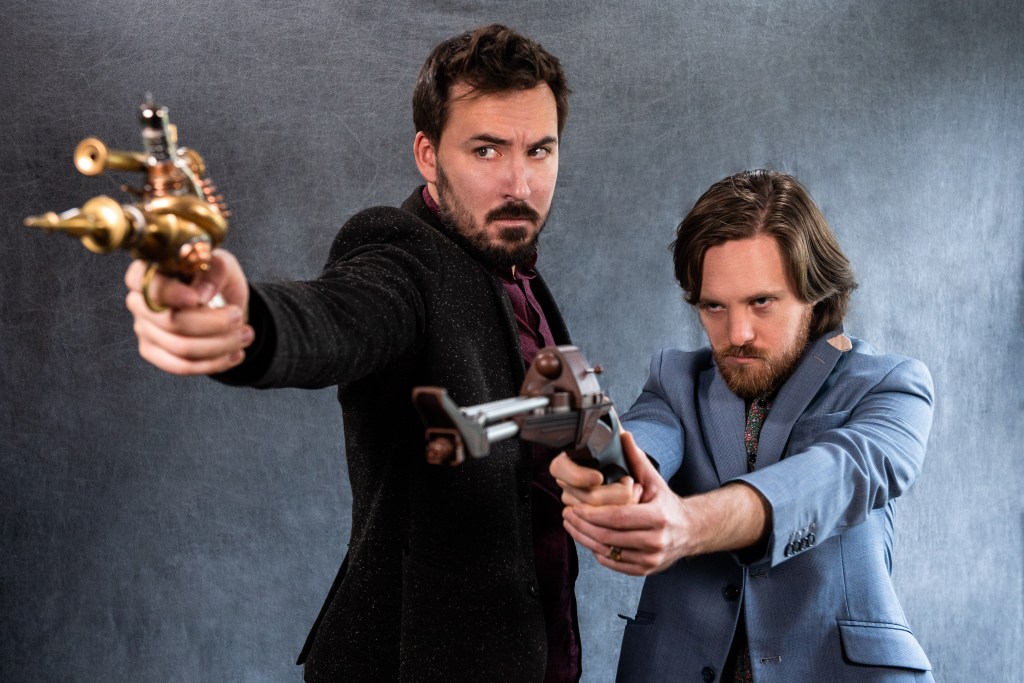
The most exciting adventures begin with the simplest of vessels. Both Kelly and Lanzing were avid table-top role-players and really wanted to create their own Star Trek adventures. Within months, they had small, persistent Star Trek universe, it swelled to over thirty player characters, over a hundred and fifty games and was essentially four seasons of television in its own right. They incorporated characters from the Federation, Romulan, Klingon and Cardassian Empires and by the end of the experience, they had learned how much they loved telling Star Trek stories. This became the core of and the first step of their Trek writing journey.
“Who gets to write Star Trek stories?’ Kelly laughs.
“We loved it,” adds Lanzing. “But what we realized from this experience was that how many people could become Star Trek fans if you gave them the right in. That game taught me that. We had friends who wanted to be part of the game but didn’t know Star Trek. We were like: that’s fine! No problem! Here’s a watch-list. Watch some Star Trek, pitch me an idea and we’ll figure something out! We had so many people become Star Trek fans through the game and saw that people could become fans if they were interested in astrophysics, or religion or they are pulp-adventurers and love that style of storytelling.”
Kelly adds: “My wife really loved sneaking around and betraying people, utterly savagely, with a knife in the back! So, she loved playing a Romulan! She was a part of the Tal’Shiar and then eventually usurped the throne for herself!
“Yeah – she was great at it!” Lanzing confirms.
Meeting new people along the way is a characteristic of an epic journey. In this case, Lanzing and Kelly were able to not only meet new people but they were able to turn them into Trek fans. That’s a pretty impressive accomplishment. “We found all sorts of entrance points for people to get into Star Trek,” says Lanzing. “So, we thought, well, shoot, If we could write something like this that gets people into Star Trek, then … “
After all this preparation, how did Year Five start?
“Jack and I have been writing together for about a decade until this point in our journey,” recounts Kelly. “Our first comic we wrote was Joyride – we pitched it as ‘teenaged punk rock in Star Trek’. We used the Kirk-Spock-McCoy triumvirate as the apex of storytelling, which if you get that, it’s the most powerful engine for storytelling in any genre. We wrote 12 issues and it remains one of our all-time favorite books. That was around when we started to get into comic book sphere, make relationships and get us to the door of IDW.”
“We literally thought: who’s going to pay us to write Star Trek? So, we wrote our own!” Lanzing says, with a laugh. After a series of different editors at IDW, eventually Lanzing and Kelly managed to find a launching point for their grand adventure. “We put together a two-year multi-book plan, to take all of the characters from TNG and Voyager and do what we had done with our role-playing game and create a multi-threaded, Game of Thrones–style of story. It was a tapestry. We had a book that was going to be a ship book, another that was going to be a station book and then a Section 31 book. They were all going to work together to tell this story and it was going to be over two years. We pitched it to IDW.”
With that pitch came the first challenge to the odyssey.
“We pitched it with all the Trek maps, the official maps of the Alpha and Beta Quadrants,” says Kelly. “We spread them all over the table – told everyone to clear their notebooks off the table – four square feet of space! We had a conspiracy board. The Federation was going to cross over into the Beta Quadrant, they’re going to face Romulan forces … we had this whole thing mapped out! The pitch lasted a while and it was gripping! They were eating out of the palms of our hands! I am happy to say it was one of our proudest pitches!”
“It was a great pitch,” Lanzing continues. “We went out for lunch with David Hedgecock afterwards and he thought it was going to happen. Awesome … let’s do it, he said. We got really, really close and then they greenlit Picard.”
This meant that Lanzing and Kelly couldn’t use the characters from TNG, so it was over and it looked like this odyssey was over before it even began.
“We went from ‘this is going to happen!’ to ‘No Star Trek for you’!” says Lanzing, with a laugh.
However, Star Trek IDW editor Chase Marotz was in the room when it happened.
“We got a call from Chase. He was like ‘Hey guys – I was in on that pitch. You clearly love Star Trek. We’re doing an issue of Star Trek: Waypoint. Are you interested? We pitched one about Data and Spot, and Spot manages to save the ship. We turned it in and suggested Sonny Liew. We never thought it would happen – but Sonny made time out of his schedule to do twelve pages of Star Trek. Lo and behold, it came out and that was our first Star Trek story.”
Chase came back to Lanzing and Kelly on the success of that story and offered them Star Trek: Year Five.
“Chase said they were going to run it like a television writers’ room,” explains Lanzing. “They were going to have writers pitch stories but if we had an idea for an over-arcing plot that would run from Issue #1 to Issue #24, then please pitch it. If that worked, we would be hired to be the showrunners. We would write the first 12 issues, run the writers’ room and then our plot would be the over-arching narrative for the rest of the story.”
With that, the odyssey was afoot.
What is striking about this series is the overwhelming attention to detail in the presentation of the characters. The dialogue reads like script lines from a TOS episode; speech patterns, turns of phrase and even body language is emulated. In Issue # 1, Page 9 in the second panel (drawn by Stephen Thompson), we see a Kirk in an all-too familiar, arms-outstretched pose as he describes the importance of the decision to become Admiral Kirk and leave Captain Kirk behind.
In Kirk’s own odyssey, this is a pivotal moment in the lore and no other series has taken the time to examine this process of the final year of the Enterprise’s return and Kirk’s career. It’s the detail that not only pays homage to that essential piece of Trek lore but gives it the reverential consideration it is due. Every TOS fan would pick up on the importance of this transitional moment.
“We didn’t want to tell Star Trek comics; we wanted to tell Star Trek stories. We had to drop our egos and tell the story that Gene Coon would have approved of. We couldn’t write Kirk as we imagined him. We had to write Kirk as Bill Shatner would have performed him.” Lanzing adds about the artistry in the series: “Stephen Thompson doesn’t just get Shatner or Kirk – he gets the essence of Kirk.”
Every odyssey needs a hero, and Kirk is at the center of this series—a decision that was made intentionally.
“We wrote a ‘bible’ heading into the writers’ room,” says Lanzing. “We noticed that comic writers love Spock. They love Bones. So, Spock and Bones get all these great stories. Kirk gets forgotten a lot in Star Trek comics because they feel like he already had the stories to begin with … He also gets lampooned a lot. When an audience thinks about Kirk, they think about a portly sex-fiend! And that’s hard – especially for people who don’t know the character. They don’t see him as the brooding, stoic warrior genius that he is, so, we saw that and Kirk needs to be at the core of this.”
Lanzing reads from the “bible” he presented to writers Jody Hauser, Brandon Easton and others in the writer’s room: “When in doubt: Kirk. James Kirk is the unabashed protagonist of this series. While Spock and Bones will both have arcs, Kirk must remain a focus. He is not the reckless youth that the Abrams movies have ingrained into the public consciousness but instead a thoughtful, mercurial warrior poet, who couldn’t bear to waste Khan’s potential in a Federation penal colony. He’s 37 years old; he’s a father who does not know his own son and he is completely without close friends other than his first officer and the ship’s doctor. In his own way, he is a tragic figure and we are catching up with him on the cusp of a life-change that we will know he will come to deeply regret. This story is about legacy and responsibility and giving up command after five years. So, think about whatever story you tell as a chance to tell the last tale of Kirk in whatever field your story attacks.”
This is the Kirk loyal fans who grew up with him as their idol would recognize. Not only is this true of the Original Series, but it is also at core, the essence of Star Trek, as Kirk is the figure who epitomized all of humanity’s passions, failings, ambitions and capacity to learn. This is James T. Kirk as he was meant to be and has now been realized in this missing gap of his career.
Along with Lanzing and Kelly, the writers’ room boasted the talents of Jody Houser, Brandon Easton, Jim McCann, and a one-shot Valentine’s Day special by Paul Cornell. The artists on this series included Stephen Thompson, Martin Coccolo, Silvia Califano, Christopher Jones, Angel Hernandez and one of my personal favorites: J.K. Woodward. The cover of the inaugural issue was by the legendary Greg Hildebrandt. The crew of the odyssey was a rich and accomplished one.
Sadly, it has to end. Why? “We ask ourselves the same ding-dang question!” Kelly answers. “It’s been the highlight of our careers to write these characters. The nature of the title suggests that it has to, but it’s something we regret every day.”
“The power of the book comes from the fact that it does end,” Jackson adds. “We know that the story is ending. We know that it is a tragic story about Kirk giving up the captain’s chair. So, we knew that we were going to land somewhere poignant. Kirk giving up that chair is inherently poignant. So, the challenge is how poignant we can make it. The real power behind this story is turning around and going home and sadly, the odyssey has to end. It’s no good if he doesn’t get back to Ithaca.”
At the time of this article, Issue #20 is the current one. We have four more issues to go, with the finale coming in July. Jackson reports that he had received the art for Issue #24 and, with that, the ship is safely at port for him. For loyal readers who are loathe to see this series end, at least there are more issues to read and enjoy until then.
On social media, fans exclaim that it should be considered canon, high praise for writers who saw the appeal of this franchise to the point that they felt they had to explore its origins, eventually writing what some consider to be the defining story of this missing period. Not only have they given fans something that is acceptable but they have done it with the kind of careful observance the television series deserved.
However, both Lanzing and Kelly take effort to report that this would not be the last time they are to be involved in writing Star Trek. Perhaps we might see them create stories within TNG, Voyager or the other iterations that this franchise has created. In that, perhaps we will see, and enjoy, other odysseys of their creation? If so, then here’s to the next journey.

